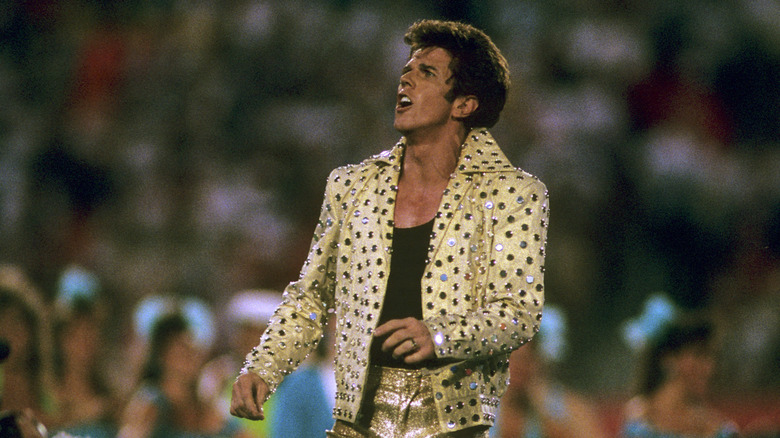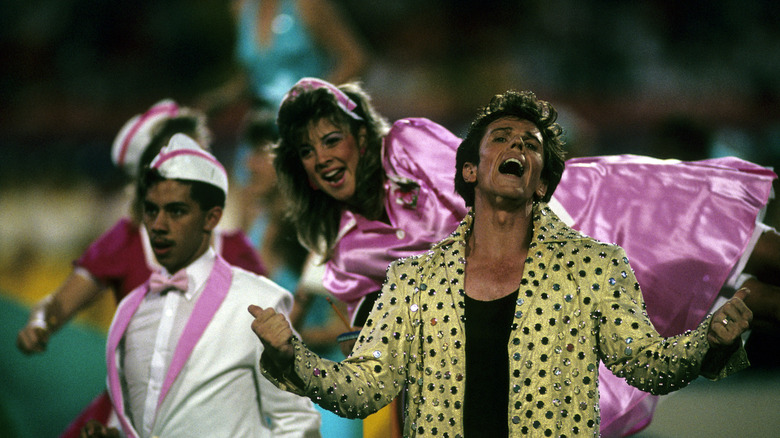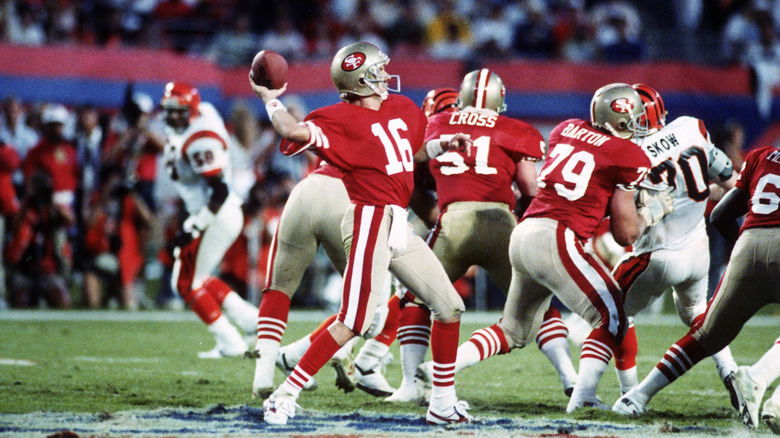The Infamous Super Bowl Halftime Show That Hired An Elvis Impersonator
It was one of the strangest spectacles ever to grace the television screen much less the halftime of a Super Bowl. NBC sportscaster Bob Costas, acting as emcee, looked nothing short of embarrassed. "Alright, before we go any further, I'd just like to say publicly, this is the single proudest moment of my life," he said while wearing 3D glasses, tongue firmly in cheek. The crew in the studio burst out laughing. It didn't bode well for what was to come.
On January 22, 1989, NBC presented the first 3D television broadcast in history, but that claim to fame couldn't save the Super Bowl XXIII halftime show from quickly earning the title "Stupid Bowl I," according to the Lexington Herald-Leader. The newspaper went on to quip that you "don't often get to see institutions the size of the National Football League and NBC make fools of themselves in public." From the gold-lamé-wearing Elvis impersonator who was also a magician to the not-quite synchronized dancing of thousands of women in poodle skirts and men in satin jackets lip-synching 1950s and '60s songs (with only a few bars of any tune Elvis ever sang). Graphics of spinning trumpets, poodles, musical notes, and records in day-glow colors only made things weirder. "What all this was supposed to signify was anyone's guess," the newspaper stated.
How it came to be
Dan Witkowski, the founder of a company called ComedyCom, sold the NFL on the idea of a halftime show centered on magic, and over many months the concept began to crystalize around a card trick involving all the Cincinnati Bengals and San Francisco 49ers fans at the Super Bowl in Miami. The people in the stadium picked one of four giant playing cards based on how loud they cheered (it was the King of Hearts).
The 1950s theme seemed somewhat of an arbitrary choice. "The whole 1950s thing was pretty big at the time," Witkowski told Mental Floss. "Baby Boomers were trying to relive their youth, so we hooked on that." Coca-Cola, which sponsored the show at the height of its cola war with Pepsi, spent a reported $7 million between the commercial it aired just before the big event and the bizarre show itself, per The Atlanta Constitution. It was Coca-Cola that had the idea for introducing the 3D element — the company gave away around 20 million pairs of the glasses so viewers could experience the effect.
Elvis Presto
The halftime show titled "Be-Bop-Bamboozled" began with Elvis impersonator Elvis Presto jumping out of a jukebox and growling "Hello baby," which was actually the Big Bopper's catchphrase — not Elvis'. Authenticity was not a high priority for the show, which used a prerecorded soundtrack. A Broadway performer, Jody LoMedico, recorded the medley in New York City, which included a 1980s Stray Cats original, a tune from "Grease," several songs from the era, but only snippets of anything resembling an Elvis tune.
After recording the music, LoMedico bailed on appearing in the halftime show in Miami. He'd gotten a Lee Jeans commercial that paid more, per the Cincinnati Enquirer. Alex Cole, who they'd hired as LeMedico's choreographer, stepped into the role of Elvis Presto. He had less than two weeks to learn the complicated setup. "I would say that Alex, as Elvis, didn't have the right look," Dan Witkowski recalled to Mental Floss. "But he didn't have the opportunity to practice, either. With magic and its complexities, it's hard to just drop someone in." Cole never appeared on stage again.
Controversy overshadowed the actual football game
The actual event was considered an epic Super Bowl: The 49ers beat the Bengals 20-16 with a touchdown pass from quarterback Joe Montana in the final minutes of the game during a 92-yard drive. Afterward, when Pete Rozelle, NFL commissioner at the time, presented the trophy to the 49ers, he expressed his belief that it was a game for the history books. "You and the great Cincinnati team gave us the finest of our 23 Super Bowls," he said (via the Associated Press). "I don't think there's any question about that."
But the next day, the press and fans were more interested in discussing the oddball halftime show. "If you aren't good enough to make it as either an Elvis impersonator or a magician, combine the two and take center stage for the Super Bowl halftime show. ... It was be-bop-bamboozling. What a country!" groused The Leader-Post. The Super Bowl XXIII halftime show still has its defenders today. "We experimented," Jim Steeg, who greenlighted the show as the vice president of special events for the NFL in 1989, told Mental Floss. " We took chances. With the Super Bowl, it's very easy to just say no. We rolled the dice."


